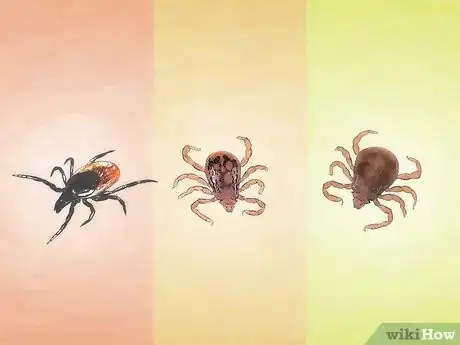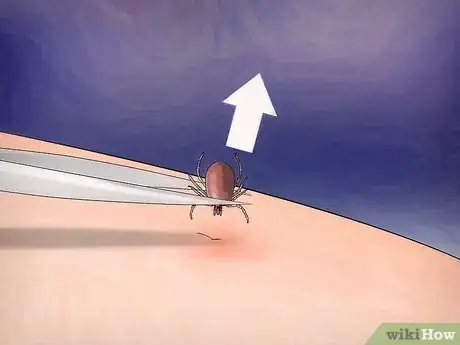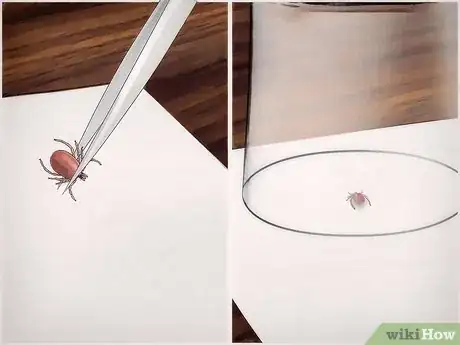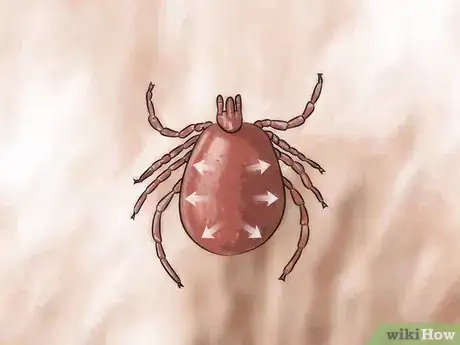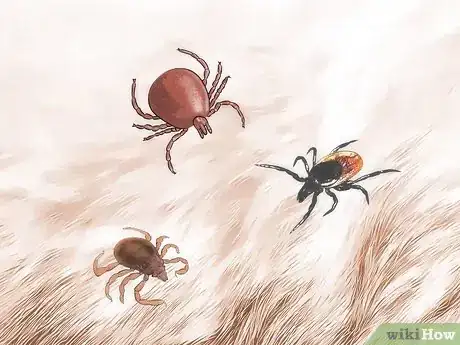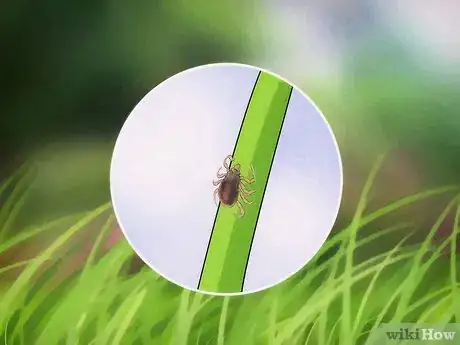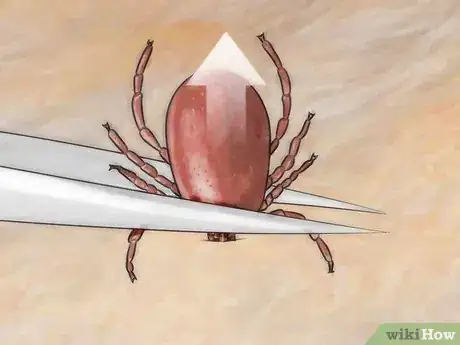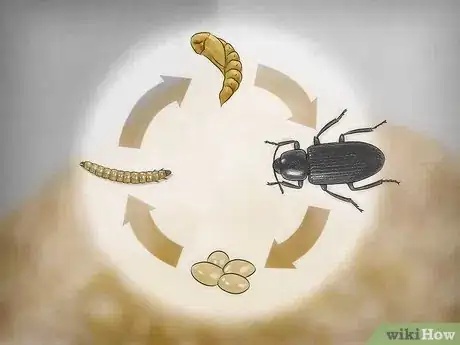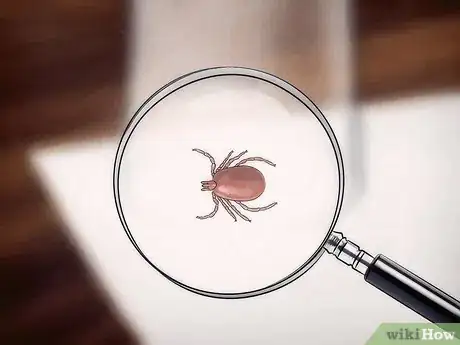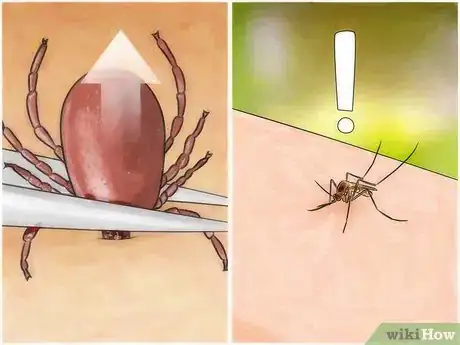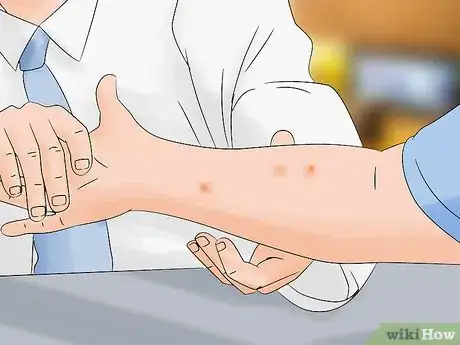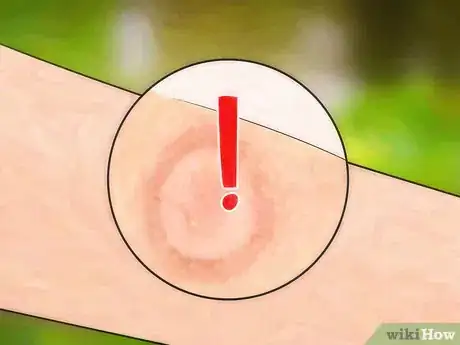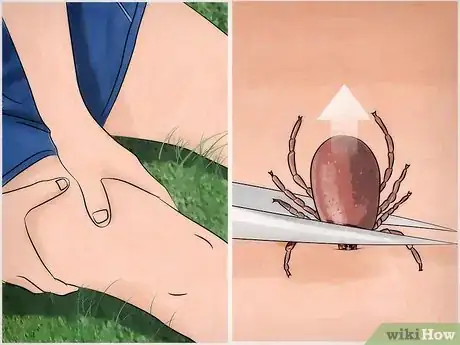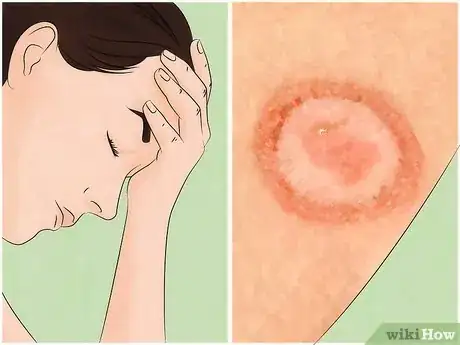This article was co-authored by Elmer Bensinger. Elmer Bensinger is a Pest Control Specialist with Eden Advanced Pest Technologies in Spokane, Washington. With over 20 years of experience, Elmer specializes in integrated pest management and products such as insecticides and rodenticides. He studied business at South Puget Sound Community College.
There are 15 references cited in this article, which can be found at the bottom of the page.
This article has been viewed 97,693 times.
While tick bites are not often painful, they can lead to infections or even chronic illnesses like Lyme disease. If you're uncertain whether you're dealing with a tick infestation, check for defining features that distinguish a tick from other bugs. Some bugs that look like ticks are harmless, but ticks must be dealt with immediately to avoid illness or infection. Call an exterminator if you're still not sure for a professional opinion.
Steps
Checking for Distinctive Tick Features
-
1
-
2Check for bugs that are between 1⁄2 to 2 in (1.3 to 5.1 cm) long. How large a tick is when you find it depends on whether it has recently fed on blood. Before it has drunk any blood, a tick will be around the size of a pinhead. Immediately to several hours afterward, a tick will grow to around the size of a lima bean.[3]Advertisement
-
3Examine its exterior for a protective hard body. In most cases, ticks have a hard exoskeleton. These are called hard or "authentic" ticks and are usually what people are talking about when describing ticks. Soft ticks with a flexible exoskeleton exist but are only found in select areas.[4]
- Soft ticks are found in the western United States and southwestern Canada.[5]
-
4Check for a star-shaped design on its back. Lone star ticks have a white, star-shaped design on their exoskeletons. If a bug does not have this design, it still may be a tick. This pattern is just a defining feature of this tick species.[6]
-
5Examine the bug for black legs. Black-legged ticks, as suggested by their name, have legs that are darker than their bodies. Like a lone star tick's black legs, this is a defining characteristic of black-legged ticks and may not be present on every tick.[7]
Differentiating Between Ticks and Other Bugs
-
1Avoid mistaking bugs with wings or antennae for ticks. Ticks do not have wings, nor do they have antennae. If you have found a bug with either, it is not a tick. Research bugs with similar characteristics to ticks but with wings or antennae if your bug in question has these.
- Poplar weevils, which are commonly mistaken for ticks, have both wings and antennae.[8]
-
2Count the number of legs to distinguish it from insects. Because ticks are a type of arachnid, like spiders and scorpions, they have 8 legs.[9] If your bug has 6, it is an insect and therefore not a tick.[10]
- If your bug has less than 6 or more than 8 legs, it is neither an insect nor arachnid but is, regardless, not a tick.
-
3Watch for bugs that feed on blood and do not travel in groups. Billbugs are the commonly mistaken for ticks because of their near-identical appearance. The way to distinguish between a tick and a billbug is to watch them. Billbugs swarm in groups, whereas ticks are usually alone. Ticks also feed on blood, whereas billbugs do not.[11]
- As a general rule, billbugs do not hang around or on people and animals. Ticks often do.
-
4Look for bugs that burrow in the skin instead of resting on its surface. Both ticks and bed bugs hang around animals and humans. Their method of feeding off of people and animals, however, differs. Ticks burrow into the skin to drink a living creature's blood but bed bugs stay on the skin's surface.
- Make sure you know whether a bug is a tick or bed bug before removing it from your skin. Without proper precautions, you may remove a tick's body while its head remains lodged in your skin.
Identifying Tick Bites
-
1Check for mild pain around the bite. Tick bites are not usually painful. If you experience sharp pain, you have not likely been bitten by a tick. Research your other symptoms to determine what insect or arachnid bit you and begin treatment.
- If a soft tick bites you, you might notice localized pain immediately after the tick drops off.[12]
-
2Inspect the site for redness. Although tick bites are not painful, they can still set off your body's immune system. If the bite and the skin surrounding it looks reddish, it may be a tick bite. Keep in mind, however, that redness is a symptom of many bug bites.
-
3Watch for rash development in the days and weeks following your bite. While not often a symptom of tick bites, you may develop a rash if your tick bite becomes infected or if you contracted an illness from the tick bite. If a rash spreads from your tick bite to other parts of your body, call your doctor or visit an urgent care clinic.[13]
- Some illnesses that ticks carry, like Lyme disease, can take months or years before symptoms develop.[14]
-
4Look for a tick still attached to your body. Because tick bites usually do not hurt, the most common way to spot a tick bite is to see the tick burrowed in your skin. Compare the bug on your body to other insects before removing it so you can use a pair of tweezers or a credit card to safely get it out of your skin. If you are not careful, tick heads can remain lodged in your skin.[15]
-
5Recognize tick bite symptoms that require immediate medical care. While most tick bites can be treated at home, you may need emergency care if you develop an infection or allergic reaction. Seek emergency medical help immediately if you notice any of the following symptoms:[16]
- Raised red bumps (hives) all over your body
- Trouble breathing
- Swelling of the mouth, lips, tongue, or throat
- Lightheadedness, dizziness, or loss of consciousness
Warnings
- If you have identified a bug on your body as a tick, do not remove it with your hands. Its head may detach from its body and stay in your skin, which can cause infections. Research how to remove it properly before you try.⧼thumbs_response⧽
References
- ↑ http://howmed.net/community-medicine/ticks-characteristics-life-cycle-and-control-measures/
- ↑ Elmer Bensinger. Pest Control Specialist. Expert Interview. 5 February 2021.
- ↑ https://www.lymediseaseassociation.org/about-lyme/tick-vectors/photos
- ↑ http://www.botanical-online.com/ticks.htm
- ↑ https://www.cdc.gov/ticks/tickbornediseases/soft-tick.html
- ↑ http://www.tickinfo.com/lonestartick.htm
- ↑ https://www.petcarerx.com/article/what-do-ticks-look-like/120
- ↑ http://www.cantonrep.com/article/20140706/News/140709599
- ↑ Elmer Bensinger. Pest Control Specialist. Expert Interview. 5 February 2021.
- ↑ https://www.cesarsway.com/dog-care/flea-and-tick/the-differences-between-fleas-and-ticks
- ↑ https://listverse.com/2016/06/18/top-10-fascinating-insect-impostors/
- ↑ https://www.emedicinehealth.com/ticks/page4_em.htm
- ↑ https://www.cdc.gov/ticks/symptoms.html
- ↑ https://www.lymedisease.org/lyme-basics/lyme-disease/chronic-lyme/
- ↑ http://kidshealth.org/en/parents/tick-bites-sheet.html
- ↑ https://www.webmd.com/skin-problems-and-treatments/tc/tick-bites-check-your-symptoms
About This Article
To identify a tick, look for a small, oval-shaped, black or brown bug that has 8 legs. Ticks don't have wings or antennas, so if you find a bug with either, it won’t be a tick. Ticks may also have a white, star-shaped design on their backs, but this is only a feature of 1 common breed of tick. Many ticks also have black legs, but not all of them. In general, ticks travel alone, so if you spot other bugs around it, it’s probably not a tick. For more tips, including how to identify a tick bite, read on.
